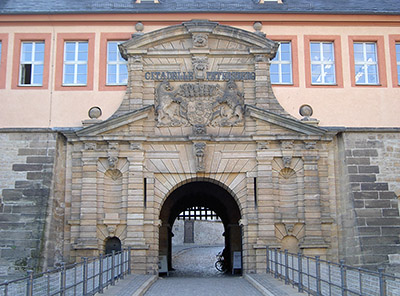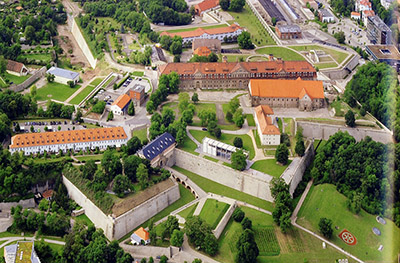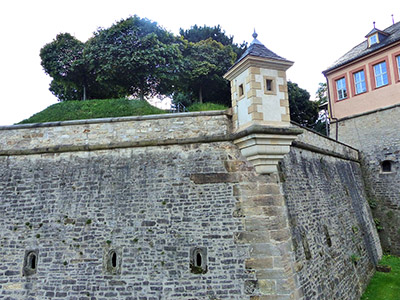 |
Zitadelle Petersberg
Erfurt, Germany
|
|
 |
Constructed: 1665-1702
Used by: Catholicism, France, Prussia, Germany
Conflicts in which it participated:
Napoleonic Wars
|
The Thirty Years War, fought primarily in Germany in the first half of the 17th century, began as a squabble betwixt Catholics and Protestants in the Holy Roman Empire. As tended to be the case in Europe, however, once someone started fighting, everyone wanted to get involved: Spain, France, Sweden, Russia, Denmark, the Netherlands, England, Poland and just about anyone else who could heft an unbearably clumsy firearm eventually managed to make their way into the fray.
The Treaty of Westphalia (1648) ended this and the Eighty Years War, in which the Dutch gained their independence from Spain.
|
 |
|
|
One of the results of this lengthy mess was that Germany was divided into many individual, sovereign territories, each needing to protect itself from everyone else. In the interest of protecting the city of Erfurt from future problems with those pesky Protestants, the first stone of Zitadelle Petersberg was laid on June 1 1665. The initial construction went on for about 40 years, until the early 18th century. With Sweden making threatening gestures in the direction of Erfurt, the authorities decided to get more Vauban-y, and the Citadelle took on a more starrish shape. Further wars of the 1770's caused even more furious digging and building on the Zitadelle.
|
 I would say this is Zitadelle Petersberg's main gate, but the starfort of our current interest is such a sprawling monstrosity that it has many gates, and as far as I know they're all this ornate and lovely. I would say this is Zitadelle Petersberg's main gate, but the starfort of our current interest is such a sprawling monstrosity that it has many gates, and as far as I know they're all this ornate and lovely. |
 |
The battles of Jena and Auerstedt, in which Napoleon (1769-1821) routed the Prussian Army, took place on October 14, 1806. About 1400 somewhat demoralized Prussian troops fled to Zitadelle Petersberg, where they bravely stood fast until Napoleon himself showed up in June of 1807 and politely asked if he might use the fort, which was instantly handed over to the French.
The Prussians returned in force, along with the Austrians and Russians, in October of 1813. A running battle through Erfurt and several surrounding villages cleansed the surrounding area of French troops, but those still holed up in Zitadelle Petersberg withstood siege and bombardment until May 5, 1814: a month after Paris had been occupied by the armies allied against Napoleon! |
|
The French force of 1700 that had been holding the Zitadelle received permission from France to hand it back over to the Prussians, whereupon they were permitted to withdraw, unmolested, to Strasbourg.
The Congress of Vienna (1814-1815), which ended the Napoleonic Wars (1803-1815), restructured Germany in complex ways that I won't even pretend to understand, but for Zitadelle Petersberg it meant even more building! With the amalgamation of disparate German states in 1871, many fortifications built to defend individual city/states from each other lost importance, and funds were vastly limited due to the overwhelming needs of forming the German Empire. The Zitadelle remained somewhat unused until Kaiser Wilhelm (1859-1941) realized how cool it was, and further improvements were made from 1912 to 1914.
|
After the First World War (1914-1918), all of Germany was at least supposed to get rid of its military capability: Zitadelle Petersberg was used as residential apartments and a police station. During the Second World War (1939-1945), the Zitadelle was further upgraded and used as a jail for political prisoners, a camp for displaced persons and a bomb shelter for citizens of Erfurt. Surely all of those folks got along well in one starfort!
The US Army captured the city and it's Zitadelle in April of 1945, but by July it was in Russian hands, as Erfurt was within the Soviet occupation zone.
|
 |
 Hard to argue with that. Hard to argue with that. |
|
Zitadelle Petersberg spent some time as commercial and administrative housing after the war, until the German Democratic Republic was founded on October 7, 1949, whereupon the fort was taken over for use of that happy new nation's state security apparatus. By 1963 the Zitadelle was back to use by the city, but as there wasn't much money to be had by anyone other than the government, the fort wasn't used for much of anything. |
 Zitadelle Petersberg sports these fancy-dan angular guérites (although I'll bet the Germans have a cooler name for them) at strategic points around it's outer walls: Not at the tip of every single bastion, but they do appear frequently. Zitadelle Petersberg sports these fancy-dan angular guérites (although I'll bet the Germans have a cooler name for them) at strategic points around it's outer walls: Not at the tip of every single bastion, but they do appear frequently. |
 |
The fall of the Berlin Wall in 1989 and reunification of Germany in 1990 made the people of Eastern Germany even happier than they'd been made by the founding of the pseudo-Soviet German Democratic Republic in 1949. In 1995, a local artist created a monument to 50 Wehrmacht deserters who had been executed at the Zitadelle in 1940 by the Nazis. Today, Zitadelle Petersberg and it's vast array of underground tunnels are investigatable by guided tour. |
|
|
|
|
|
|
 |




